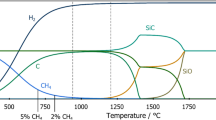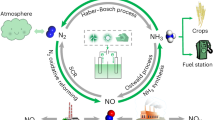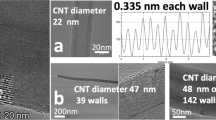Abstract
RECENT reports1–3 have indicated that the reaction of atomic oxygen with carbonaceous materials proceeds rapidly at room temperature and that the reaction has a zero activation energy. Investigations in this laboratory using several carbons have not confirmed these previous results. In the work recorded here, atomic oxygen was formed in a flow system (335 cm3 h−1 S.T.P., 0.13 mm mercury pressure) by the action of a high-frequency (28 Mc/s) electrode-less discharge. The oxygen gas was of British Oxygen Co. medical quality and was used without further purification. During the discharge the plasma was found to extend considerable distances down-stream from the generator coil. The extent of spread of the plasma could be limited by wrapping the glass tubing on either side of the generator coil with earthed aluminium foil. The concentration of atomic oxygen at the position of the carbon specimen was about 10 per cent. This concentration was measured calorimetrically using the method described by Schiff4. The carbon was contained in a silica boat and suspended in a silica reaction vessel. Facilities were available for outgassing the carbon at 900° C to pressures less than 10−5 mm mercury before reaction. The carbons used included purified Ticonderoga graphite crystals5, pyrolytic graphite, and various pure amorphous carbons.
This is a preview of subscription content, access via your institution
Access options
Subscribe to this journal
Receive 51 print issues and online access
$199.00 per year
only $3.90 per issue
Buy this article
- Purchase on Springer Link
- Instant access to full article PDF
Prices may be subject to local taxes which are calculated during checkout
Similar content being viewed by others
References
Blackwood, J. D., and McTaggart, F. K., Austral. J. Chem., 12, 114 (1959).
Streznewski, J., and Turkevitch, J., Proc. Third Conf. Carbon, Buffalo, 1957, 273 (Pergamon Press, 1959).
Claxton, K. T., U.K.A.E.A. Rep. GEM/UK/40.
Elias, L., Ogrizlo, E. A., and Schiff, H. I., Canad. J. Chem., 37, 1680 (1959).
Hughes, E. E. G., and Thomas, J. M., Nature, 193, 838 (1962).
Hennig, G. R., Dienes, G. J., and Kosiba, W., Proc. Second U.N. Intern. Conf. Peaceful Uses of Atomic Energy, Geneva, 1958, 7, 301 (1958).
Author information
Authors and Affiliations
Rights and permissions
About this article
Cite this article
MARSH, H., O'HAIR, E., REED, R. et al. Reaction of Atomic Oxygen with Carbon. Nature 198, 1195–1196 (1963). https://doi.org/10.1038/1981195a0
Issue Date:
DOI: https://doi.org/10.1038/1981195a0
This article is cited by
-
Reaction Kinetics of the Atomic Oxygen-Graphite System
Nature (1963)
Comments
By submitting a comment you agree to abide by our Terms and Community Guidelines. If you find something abusive or that does not comply with our terms or guidelines please flag it as inappropriate.



